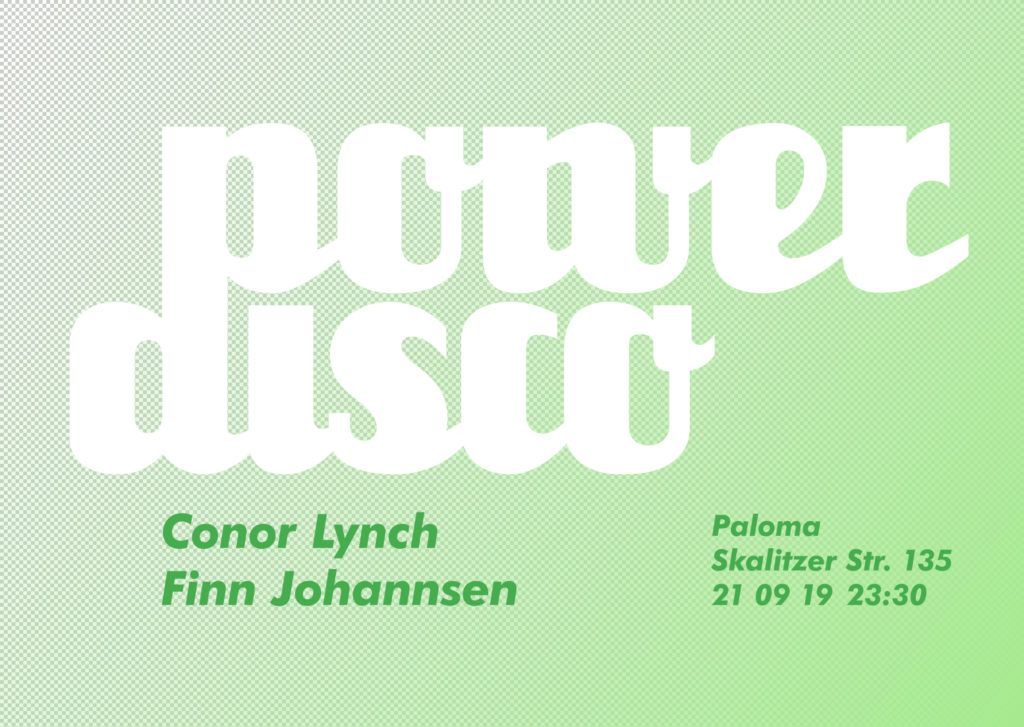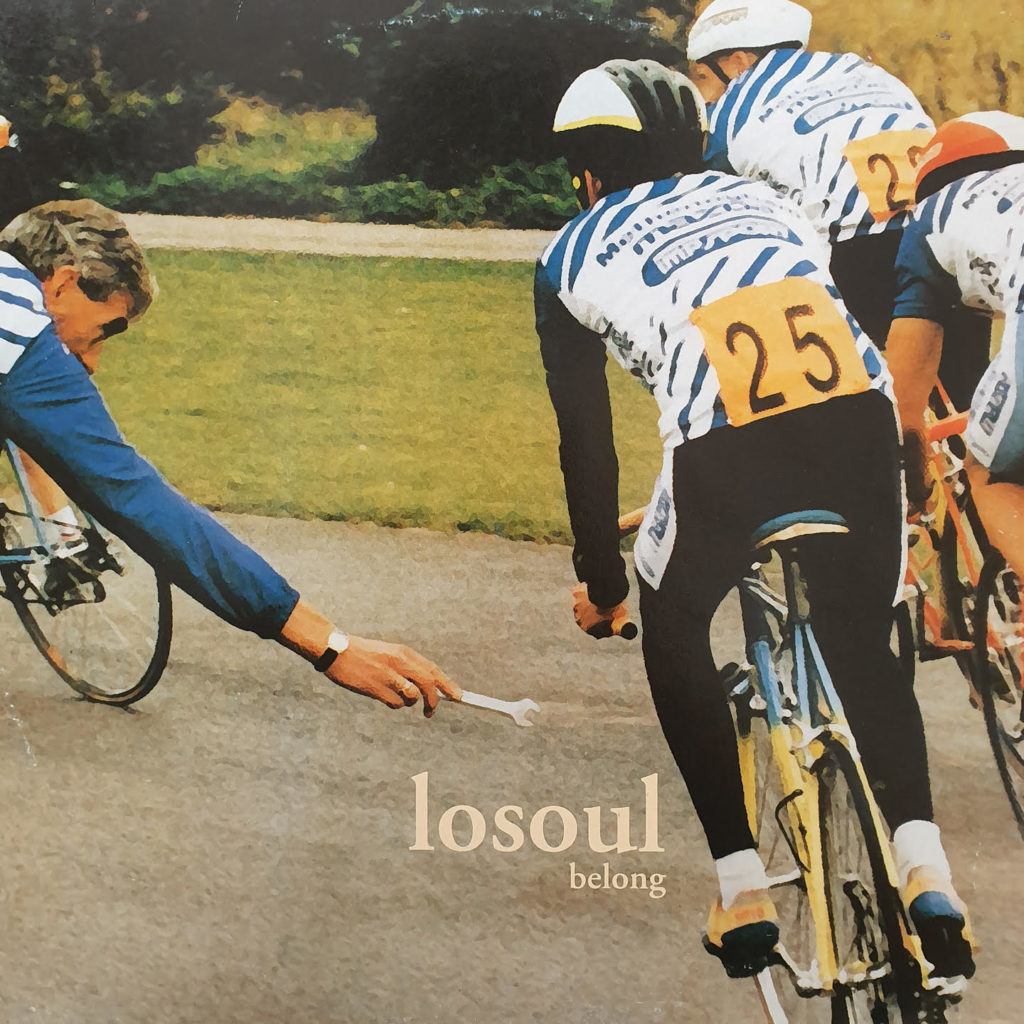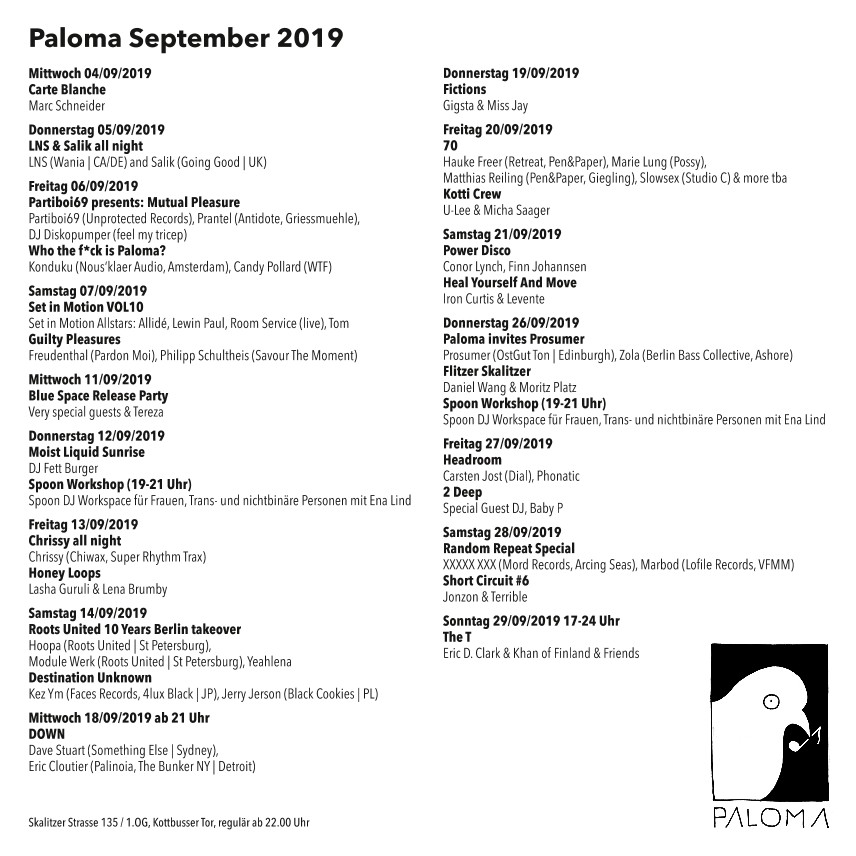Conor Lynch & Finn Johannsen live at Power Disco, Paloma, Berlin, September 21st, 2019.
Posted: September 30th, 2019 | Author: Finn | Filed under: Gigs, Mixes | Tags: Conor Lynch, Finn Johannsen, Mix, Paloma | No Comments »


There were several reasons for the popularity of minimal techno and house in the late 90s and early 00s. For one, a lot of electronic club music of the preceding years was quite boisterous. Its ingredients and purpose was often not exactly subtle, satisfying clubbers and listeners that emerged from the acid house and rave days with direct signals and relentless dancefloor dynamics. And as soon as a sound becomes too dominant in the club scene, there is a reaction, and alternatives develop, and as it happened with the minimal approach they might even take over what was happening before and become dominant as well. And a freshly initiated influx of dancers and listeners had also come with different musical requirements. While the big room and big festival acts like Prodigy and the Chemical Brothers converted a rock clientele to the dance floor, a lot of people who earlier preferred less heavier independent rock music fell in love with the early Detroit minimal techno prototypes by Robert Hood , Jeff Mills, Richie Hawtin and Daniel Bell, and its more dubbed out counterparts around the Berlin conglomerate of Basic Channel and its affiliated labels, or Wolfgang Voigt with his Profan and Studio 1 imprints in Cologne, or Force Inc. and later Perlon in Frankfurt or Säkhö in Finland, or Peter Ford‘s Ifach and Trelik labels. Furthermore the club scene itself went through changes. Budget airlines stormed the market and made travelling to parties affordable, new open air venues and festivals entered the circuit but they had to make concessions to surrounding areas and embraced a sound that was efficient without significantly loud and low end sound systems. Also drugs like ketamine or GHB became popular and their users liked a sound that was more reduced, hypnotic and subtle. And soon enough minimal techno crossed over to house as well, and was out to conquer.
Right in the centre of these developments was the Frankfurt imprint Playhouse founded by Ata and Heiko M/S/O, which began as the housier end of parent label Ongaku Musik, along with its fellow sub label Klang Elektronik. It put artists like Ricardo Villalobos on the map, as well as Isolée or Roman Flügel with his Roman IV or Soylent Green aliases, and they reinterpreted house music with a lot of attention to details, abstraction, reduction and repetition. Peter Kremaier aka Losoul was arguably the most defining artist in the label‘s early stages, and his productions had a signature sound that is still unique. He probably was inspired by the layering experiments of DJ Pierre‘s wild pitch sound or the immersive deep house of Ron Trent and Chez Damier, but his own tracks soon took off into their own creative zone. Beginning with 1996‘s „Open Door“ the following 12“ releases „Mandu“, „Don Disco De Super Bleep“, and „Synchro“ were masterclasses in dancefloor mesmerism. Over beats more pumping than those of his label peers, subliminal percussion and chopped chords, he worked with deconstructed disco and funk loops and occasional vocal samples that were so perfectly captivating that he could ride them over extended tracks that gradually introduced element after element with logical patience, resulting in trips you felt should never stop. But by the end of the 90s the structure of his tracks became less strict, and he also explored different sounds on dark, bass heavy tracks like „Ex.or.zis.mus“ or „Brother In Love“, to fine effect. It seemed what was still needed was an album to round up this artistic phase of his, before he would potentially venture into something new, or different.
When said album „Belong“ was then released in 2000, it came as surprise to many of his followers. The opener „Taste Not Waste“ is deceiving, as it is a brooding punchy excursion that would not have been out of place on the preceding 12“s, but already the following track „Late Play“ is a weird off-centre sounding sketch in comparison, hinting at the fact that the artist would not give away the chance to represent more of his repertoire than his trademark club stylings. „Resisting Curare“ takes up on the quirkiness, albeit speedier, while „Overland“ is an eccentric and playful take on the ever reliable Billie Jean groove, coming across like a cross between the original groove and „Kaw-Liga“ by The Residents, with extra weirdness. Then things take another unexpected turn with „Sunbeams And The Rain“, which in my humble opinion is one of the most astonishingly beautiful and sublime tracks ever to merge deep house and techno. Only slightly erratic, this majectic masterpiece is followed by the chunky slow groover „Position“, which dubs down the proceedings before the sparsely tripping yet funky „Depth Control“, another demonstration how much you can achieve with just a few thought-out, gripping elements. Next is „You Can Do“, which contains the sunniest loop Kremeier produced up to that point, a spiralling, almost balearic melody which does not let go for most of the track, thus resulting in another track you can completely lose yourself in, although it achieves that typically intense Losoul sensation with an untypical joyful mood. The last track „Trust“ is a warped and chopped hip hop version of Bill Withers‘ „Use Me“ that would grace any tape of later L.A. beatmakers, and it makes you wonder what whole other sounds the artist might have left in the vaults.
Although Losoul has continued to drop releases of consistent quality, I think „Belong“ marks the end of a certain era, in which he acted as a true solitaire, even among likeminded and similarly talented cohorts. To me it seems that only shortly after the imaginative ideas of the minimal techno and house of those years time soon were often forsaken for a sound that was already looming, more eager to please, and less interesting to listen and dance to, however exceptions might prove the rule. But it is undeniable that here lies the foundation for many backlashes and resurgences to come.
Resident Advisor September 2019

There was this moment in the 90s when the sound of house music changed, with lasting consequences. I would say it began in 1993. Of course technical progress in terms of production techniques and equipment played a role, but it was also very important that the music itself became more popular, and attracted bigger crowds, which led to bigger clubs, and a house sound that pumped crowds and clubs of that size sufficiently. In the following years the superclubs emerged with corresponding budgets, and they needed DJs that played accessible enough to please and unite as many people as possible. This created a divide between denonimators, as simultaneously a lot of DJs and producers defined quality in a different way, and played different styles, to smaller crowds, in smaller clubs. There were DJs and artists that lived in both worlds, or crossed over, and both worlds had different levels of credibility, and success. But increasingly the circuits frowned upon each other, and disrespect was mutual. The big room house music examined here was produced at a time when it had a really bad reputation, being accused of being commercial, devoid of original ideas, or milking once original ideas for far too long. Indeed the sound templates for the music in this playlist had been established years before, and it seemed as if they were only developed further if really necessary. Some of the big room artists were once renowned for different music, and many were quick to maintain that at some point they were selling out and adapting to lesser creative requirements to do so. And some smaller room artists were maybe just envious and could not produce a tune that sold as well, and just claimed they did no want to. And of course for a lot of people it does not matter what size the room has, they just go for music based on their individual preferences, and find that in different contexts. But meanwhile in the early 00s, big room house had its apex of booming beats, dramatic breakdowns and disco samples, and here are some prime examples of the sound.
Victor Simonelli – Ease Into The Dance (Stellar, 2000)
Victor Simonelli has many great moments in his back catalogue, and in my opinion this on par with his most cherished productions. For me the combination of the bodiless vocal sample and the pumping yet and elegant deep groove is as immersive as Love Inc.’s “Life’s A Gas”. I’m serious.
Lenny Fontana & DJ Shorty – Chocolate Sensation (Original Force Mix) (FFRR, 2000)
Johnny Hammond’s early disco staple “Los Conquistadores Chocolates” was sampled countless times, but not as sweeping as on this belter. Extra props for the extended filter break which then erupts into Loleatta Holloway on the top of her lungs. This track pushes all the right buttons, and works although you can predict any move, only that every move sounds even more striking than the one before. If you have never been on a dancefloor exploding to this, you really missed out.
Groove Assassins – Everything I Knew (Black Vinyl, 2000)
If some of the orchestral disco maestros would have still been active in the 90s their music could have sounded like this. Even if this is just a reconstructed original from their heyday, with a heavily beefed up groove. Nick Moss and Will Hague understood the craft of their forebearers on this track, and they made it their own.
Rhythm Section Feat. Donald O – Do You Know (Main Mix) (MAW Records, 2000)
Every disco DJ should bring at least one Chic Organization production to their party, and every disco loving house producer should sample at least one as well. Henry Maldonado went for “My Forbidden Lover” and then he turned it into a glorious garage opus, co-written and performed by the great Donald O. This should have been much bigger than it actually was, but it is never too late.
David Bendeth – Feel The Real (Jazz-N-Groove Ultra Classic Mix) (Audio Deluxe, 2000)
“Feel The Real”was indeed an ultra classic, albeit on the jazz funk/disco circuit of the 80s. By the time this was released Jazz-N-Groove had perfected their slick but heavy groove template so impressively that they basically could have applied it to any tune they were given and come up trumps. Judging by their vast output, some say they did just that.
LoveRush – Luv 2 See Ya (Joey Negro’s Vocal Mix) (Azuli, 2000)
Joey Negro always knew how euphoria works, and here he aimed straight to the highest level of it. There is some sweet innocence about the tune, but the pumping groove underneath and several breakdown dramas tell you to work it. Hard.
Copyright Presents One Track Mind – Where Would You Be? (Main Mix) (Soulfuric Trax, 2000)
The way D-Train’s “Music” is filtered up and down here is very reminiscent of the finer moments of the French House phenomenon, but the groove somehow is not. It is just too pushy and impatient, and the vocal samples get a more generous treatment, verging on harmony. All good decisions.
Johnny D & Nicky P – Wild Kingdom (4th Floor Records, 2001)
Of course big room productions could work well with deeper sounds, and Johnny D and Nicky P aka Johnick knew how to achieve severe dancefloor hypnotism anyway. As always when they are in charge, the music has this strangely psychedelic notion, and „Wild Kingdom“ is another of their real gems to get lost in.
Sunshine Anderson – Heard It All Before (E-Smoove House Filter Mix) (Atlantic, 2001)
E-Smoove was mostly not as smoove in the 00s as he had been before (but who in this field actually was), but if you remix a sleek R&B hit, you cannot fire on all cylinders. Still this has the right amount of infectious funk and it does not divert any attention from the song. If you think of the proximity to garage vocal harmonies there were, rather surprisingly, not that many great remixes that managed to aptly transfer R&B to a house context, but this one gave a lot of the right clues.
Kraze – The Party 2001 (Love City Club Remix 2) (Groovilicious, 2001)
It reads so unimaginative, taking Todd Terry’s “Can You Party” and the acapella from Kraze’s “The Party”, two early house productions that were completely overused at that point, and turn them into a fierce banger that pretends New York City’s big room haven Sound Factory never closed. And actually the way the track works all that is really not that inventive. But as it steamrolls you on that floor, you will not care one bit.
UBP Feat. Bobby Pruitt – We Are One (Jazz-N-Groove Hands Up Vocal) (Soulfuric Recordings, 2001)
I love how this mean little melody never lets up, totally regardless of the fact that there is a funky booming bassline, a quite shouty soul singer, a female choir, and several breakdowns, the whole big room house gospel spectrum. This is a big show, but one detail steals it. Genius.
DJ Oji – We Lift Our Hands In The Sanctuary (Anniversary Vocal) (Sancsoul Records, 2001)
The original was one of the churchiest of the churchy house anthems, a whole nocturnal service for those who need the club as a shelter and a place for relief and rejoicing. 95 North remix it into a way more urgent groove, but do not sacrifice any of the worship and righteous spirit. Hands were lifted and love was alive, again.
Jon Cutler Feat. E-Man – It‘s Yours (Kaze Retro Mix) (Chez Music, 2002)
The original was a jazzy funked up groover that was hugely popular, but Frankie Feliciano boldly opted for a complete rework, keeping the keen message intact but underlying it with unsettling and swirling sounds and beats that reference Pépé Bradock‘s „Deep Burnt“ and a lot of earlyTodd Terry productions.
Los Jugaderos – What You Doing To This Girl? (Norman Jay’s Good Times Re-Edit) (Junior Boy’s Own, 2003)
In 1996 Ashley Beedle and Phil Asher turned a marvellous 1979 disco gem by Dazzle into a blinding and tripping house excursion. Seven years later the original rare groove don Norman Jay gave it a remix, and when I read about that then I was expecting it to sound truer to the Dazzle original and Jay’s own legacy. But to my surprise his version was way punchier, and to my joy he highlighted all the best bits even more. Pure disco house bliss.
Hardsoul Feat. Ron Carroll – Back Together (Classic Main Mix) (Soulfuric Recordings, 2003)
Nothing better than to conclude a fine time at the big room house club with a big room soulful vocal house hymn. Even better when that tune is ever so slightly less big roomy than what happened before, but still easily keeps up the intensity and punch, just because it is a wonderful piece of music that knows and serves its context. From here you may start all over again or leave it behind, but both happily.
Electronic Beats 08/19

Macro M58 – Maria Chavez- Plays



Recent Comments